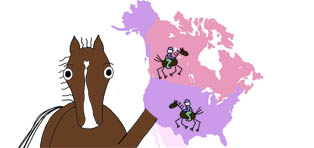IdahoEquinehospital.com/blog
May 18th, 2011
IEH update on EHV-1 outbreak 5/18/11
As we monitor this situation we would like to keep you updated on current information.
We are continuing to monitor the horses on the farms that had the two horses that were euthanized. As of this morning, no additional horses that did not travel to the show in Ogden have shown clinical signs of herpes.
While it is true that vaccination does not prevent the neurologic form of the disease in horses that are infected-there is some evidence to support that vaccination may play a role in limiting shedding of the virus if a horse becomes infected-thus potentially limiting spread within an exposed group of horses. The decision to vaccinate will depend on a horse’s known exposure risk and history of vaccination and will vary by individual.
Nebraska has elected to enforce quarantines on five farms that had horses that were potentially exposed at the Ogden show.
see link: http://blogs.equisearch.com/horsehealth/2011/05/16/nebraska-quarantine-equine-herpes-virus-ehv/
Colorado is currently reporting 2 confirmed cases of EHV-1 and 6 with clinical signs of EHV-1 that are undergoing testing. 2 horses in that state have been euthanized.
California currently has 10 confirmed cases. All of the confirmed cases were at the cutting show in Ogden. One of the horses has been euthanized.
No states have shut their borders. Colorado is not restricting horses entering the state but they have changed their rules to require a permit-see link: http://www.colorado.gov/cs/Satellite?blobcol=urldata&blobheader=text%2Fhtml&blobkey=id&blobtable=MungoBlobs&blobwhere=1251713839578&ssbinary=true
We are still early into this outbreak, and we do not yet know how likely the disease is to be transmitted to additional horses who were exposed to horses that attended the Odgen event. We are continuing to recommend that horses that attended the cutting event in Ogden remain at home and that horses that are currently on the premises that had horses come home from Ogden remain there until we can determine how and if it will spread to in-contact horses. Limiting horse movement and commingling and common sense biosecurity measures still remain the best tools we have for limiting the spread of this disease.
Some resources for additional information:
UC Davis website: http://www.vetmed.ucdavis.edu/ceh/ehv1_general.cfm
We will continue to update you as more information becomes available. Please do not hesitate to contact us if you have additional questions.

No comments:
Post a Comment